2011 Hyundai Santa Fe jump start
[x] Cancel search: jump startPage 231 of 312

Driving your vehicle
28
5
WARNING - Jacked vehicle
Whilst the full-time 4WD vehicle is
being raised on a jack, never startthe engine or cause the tyres to
rotate.
There is the danger that rotating
tyres touching the ground could
cause the vehicle to go off the jack
and to jump forward.WARNING
Your vehicle is equipped with tyres
designed to provide safe ride and
handling capability. Do not use a
size and type of tyre and wheel that
is different from the one that is
originally installed on your vehicle.
It can affect the safety and perform-
ance of your vehicle, which could
lead to steering failure or rollover
and serious injury. When replacing
the tyres, be sure to equip all fourtyres with the tyre and wheel of the
same size, type, tread, brand and
load-carrying capacity. If you never-
theless decide to equip your vehi-
cle with any tyre/wheel combina-
tion not recommended by
HYUNDAI for off road driving, you
should not use these tyres for
motorway driving.WARNING - Rollover
As with other Sports Utility Vehicle
(SUV), failure to operate this vehi-
cle correctly may result in loss of
control, an accident or vehicle
rollover.
Utility vehicles have a significant- ly higher rollover rate than other
types of vehicles.
Specific design characteristics (higher ground clearance, nar-
rower track, etc.) give this vehicle
a higher centre of gravity than
ordinary vehicles.
A SUV is not designed for corner- ing at the same speeds as con-
ventional vehicles.
Avoid sharp turns or abrupt manoeuvres.
In a rollover crash, an unbelted person is significantly more like-
ly to die than a person wearing a
seat belt. Make sure everyone in
the vehicle is properly buckledup.
Page 238 of 312

535
Driving your vehicle
✽✽NOTICE
When you jump start your vehicle
because of a drained battery, the engine
may not run as smoothly and the ABS
warning light may turn on at the same
time. This happens because of the low
battery voltage. It does not mean your
ABS is malfunctioning.
Do not pump your brakes!
Have the battery recharged before driving the vehicle.
E070500AUN-EE
Electronic stability program (ESP) (if equipped)
The Electronic Stability Program (ESP)
system is designed to stabilize the vehi-
cle during cornering manoeuvres. ESP
checks where you are steering and
where the vehicle is actually going. ESP
applies the brakes at individual wheels
and intervenes in the engine manage-
ment system to stabilize the vehicle.
CAUTION
If the ABS warning light is on and
stays on, you may have a problemwith the ABS. In this case, howev-er, your regular brakes will work normally.
The ABS warning light will stay on for approximately 3 seconds afterthe ignition switch is ON. During that time, the ABS will go throughself-diagnosis and the light will gooff if everything is normal. If thelight stays on, you may have aproblem with your ABS. Contact aHYUNDAI authorised repairer as soon as possible.
CAUTION
When you drive on a road having poor traction, such as an icy road,
and operate your brakes continu-ously, the ABS will be active con-tinuously and the ABS warning light may illuminate. Pull your
vehicle over to a safe place andstop the engine.
Restart the engine. If the ABS warning light is off, then your
ABS system is normal.Otherwise, you may have a prob- lem with the ABS. Contact aHYUNDAI authorised repairer as
soon as possible.
W-78OCM050008R
Page 272 of 312
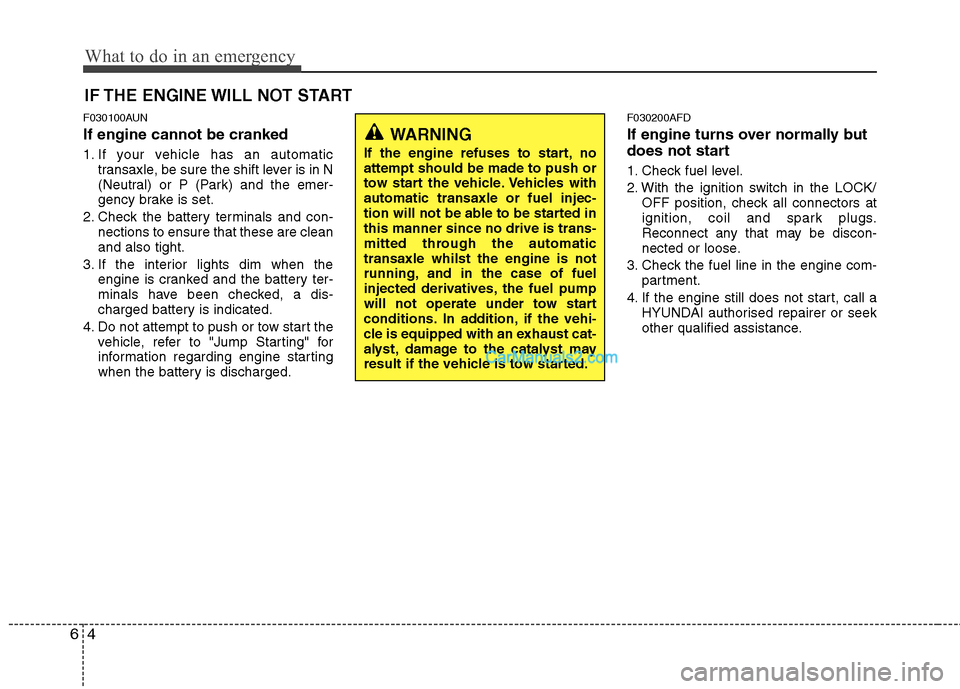
What to do in an emergency
4
6
IF THE ENGINE WILL NOT START
F030100AUN If engine cannot be cranked
1. If your vehicle has an automatic transaxle, be sure the shift lever is in N
(Neutral) or P (Park) and the emer-
gency brake is set.
2. Check the battery terminals and con- nections to ensure that these are cleanand also tight.
3. If the interior lights dim when the engine is cranked and the battery ter-
minals have been checked, a dis-
charged battery is indicated.
4. Do not attempt to push or tow start the vehicle, refer to "Jump Starting" for
information regarding engine starting
when the battery is discharged. F030200AFD
If engine turns over normally but
does not start
1. Check fuel level.
2. With the ignition switch in the LOCK/
OFF position, check all connectors at
ignition, coil and spark plugs.
Reconnect any that may be discon-
nected or loose.
3. Check the fuel line in the engine com- partment.
4. If the engine still does not start, call a HYUNDAI authorised repairer or seek
other qualified assistance.
WARNING
If the engine refuses to start, no attempt should be made to push or
tow start the vehicle. Vehicles withautomatic transaxle or fuel injec-
tion will not be able to be started inthis manner since no drive is trans-
mitted through the automatictransaxle whilst the engine is not
running, and in the case of fuel
injected derivatives, the fuel pump
will not operate under tow start
conditions. In addition, if the vehi-
cle is equipped with an exhaust cat-
alyst, damage to the catalyst may
result if the vehicle is tow started.
Page 273 of 312
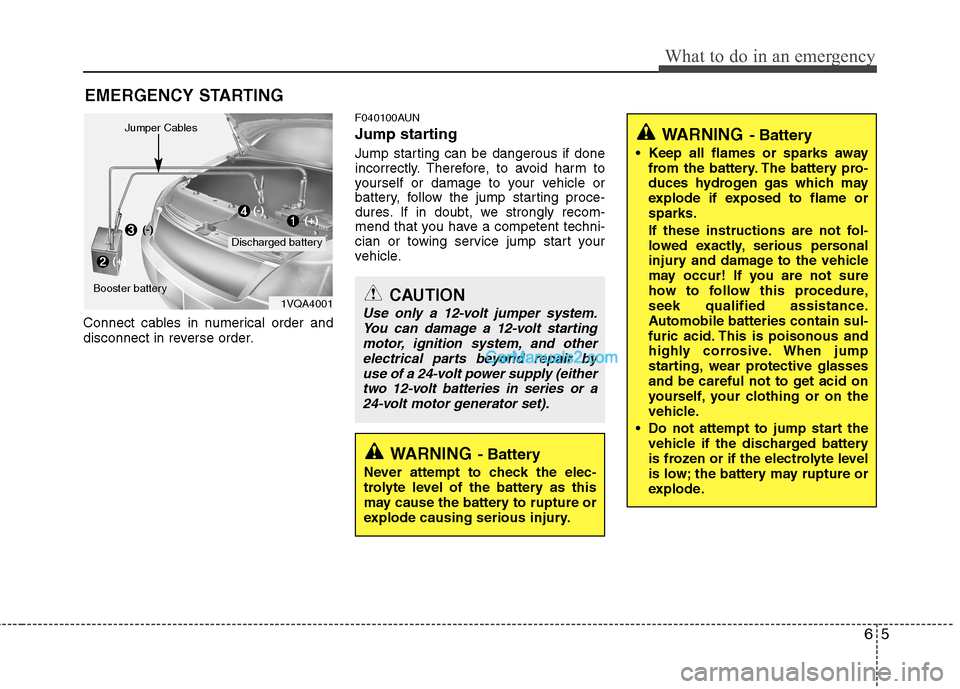
65
What to do in an emergency
EMERGENCY STARTING
Connect cables in numerical order and
disconnect in reverse order. F040100AUN
Jump starting
Jump starting can be dangerous if done
incorrectly. Therefore, to avoid harm to
yourself or damage to your vehicle or
battery, follow the jump starting proce-
dures. If in doubt, we strongly recom-
mend that you have a competent techni-
cian or towing service jump start your
vehicle.
CAUTION
Use only a 12-volt jumper system.
You can damage a 12-volt starting
motor, ignition system, and otherelectrical parts beyond repair byuse of a 24-volt power supply (eithertwo 12-volt batteries in series or a
24-volt motor generator set).
WARNING - Battery
• Keep all flames or sparks away from the battery. The battery pro-
duces hydrogen gas which may
explode if exposed to flame orsparks.
If these instructions are not fol-
lowed exactly, serious personal
injury and damage to the vehicle
may occur! If you are not sure
how to follow this procedure,
seek qualified assistance.
Automobile batteries contain sul-
furic acid. This is poisonous and
highly corrosive. When jump
starting, wear protective glasses
and be careful not to get acid on
yourself, your clothing or on the
vehicle.
Do not attempt to jump start the vehicle if the discharged battery
is frozen or if the electrolyte level
is low; the battery may rupture or
explode.
WARNING - Battery
Never attempt to check the elec-
trolyte level of the battery as this
may cause the battery to rupture or
explode causing serious injury.
1VQA4001
Discharged battery
Jumper Cables
Booster battery(-)
(+)
(+)(-)
Page 274 of 312
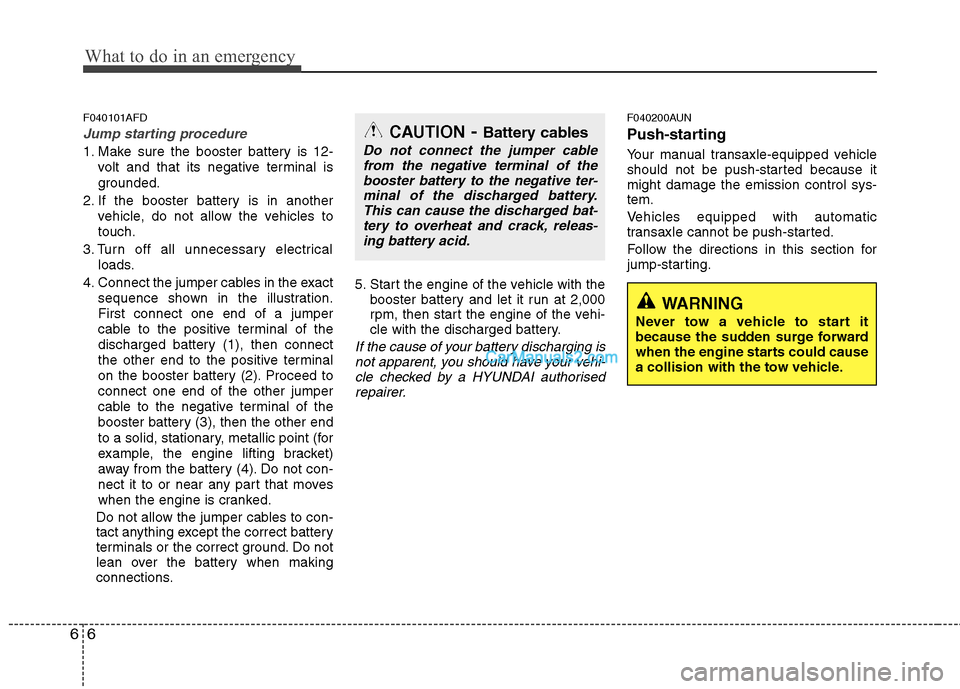
What to do in an emergency
6
6
F040101AFD
Jump starting procedure
1. Make sure the booster battery is 12-
volt and that its negative terminal is
grounded.
2. If the booster battery is in another vehicle, do not allow the vehicles totouch.
3. Turn off all unnecessary electrical loads.
4. Connect the jumper cables in the exact sequence shown in the illustration.First connect one end of a jumper
cable to the positive terminal of the
discharged battery (1), then connect
the other end to the positive terminal
on the booster battery (2). Proceed toconnect one end of the other jumper
cable to the negative terminal of the
booster battery (3), then the other end
to a solid, stationary, metallic point (for
example, the engine lifting bracket)
away from the battery (4). Do not con-
nect it to or near any part that moves
when the engine is cranked.
Do not allow the jumper cables to con-
tact anything except the correct battery
terminals or the correct ground. Do not
lean over the battery when making
connections. 5. Start the engine of the vehicle with the
booster battery and let it run at 2,000
rpm, then start the engine of the vehi-
cle with the discharged battery.
If the cause of your battery discharging is
not apparent, you should have your vehi-cle checked by a HYUNDAI authorised repairer.
F040200AUN
Push-starting
Your manual transaxle-equipped vehicle
should not be push-started because itmight damage the emission control sys-tem.
Vehicles equipped with automatic
transaxle cannot be push-started.
Follow the directions in this section for
jump-starting.
WARNING
Never tow a vehicle to start it
because the sudden surge forward
when the engine starts could cause
a collision with the tow vehicle.
CAUTION - Battery cables
Do not connect the jumper cable
from the negative terminal of the
booster battery to the negative ter-minal of the discharged battery.This can cause the discharged bat- tery to overheat and crack, releas-
ing battery acid.
Page 306 of 312
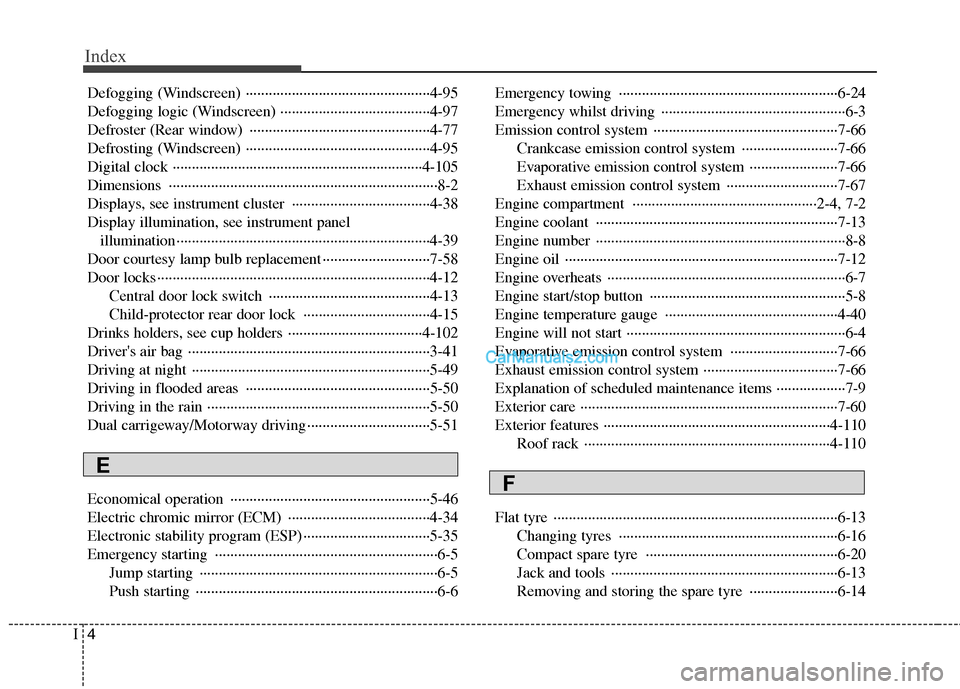
Index
4
I
Defogging (Windscreen) ················································4-95
Defogging logic (Windscreen) ·······································4-97
Defroster (Rear window) ···············································4-77
Defrosting (Windscreen) ················································4-95
Digital clock ·································································4-105Dimensions ······································································8-2
Displays, see instrument cluster ····································4-38
Display illumination, see instrument panel
illumination··································································4-39
Door courtesy lamp bulb replacement ····························7-58
Door locks ·······································································4-12 Central door lock switch ··········································4-13
Child-protector rear door lock ·································4-15
Drinks holders, see cup holders ···································4-102
Driver's air bag ·······························································3-41
Driving at night ······························································5-49
Driving in flooded areas ················································5-50
Driving in the rain ··························································5-50
Dual carrigeway/Motorway driving ································5-51
Economical operation ····················································5-46
Electric chromic mirror (ECM) ·····································4-34
Electronic stability program (ESP) ·································5-35
Emergency starting ··························································6-5 Jump starting ······························································6-5
Push starting ·······························································6-6 Emergency towing ·························································6-24
Emergency whilst driving ················································6-3
Emission control system ················································7-66
Crankcase emission control system ·························7-66
Evaporative emission control system ·······················7-66
Exhaust emission control system ·····························7-67
Engine compartment ················································2-4, 7-2
Engine coolant ·······························································7-13
Engine number ·································································8-8
Engine oil ·······································································7-12
Engine overheats ······························································6-7
Engine start/stop button ···················································5-8
Engine temperature gauge ·············································4-40
Engine will not start ·························································6-4
Evaporative emission control system ····························7-66
Exhaust emission control system ···································7-66Explanation of scheduled maintenance items ··················7-9
Exterior care ···································································7-60
Exterior features ···························································4-110 Roof rack ································································4-110
Flat tyre ··········································································6-13 Changing tyres ·························································6-16
Compact spare tyre ··················································6-20
Jack and tools ···························································6-13
Removing and storing the spare tyre ·······················6-14
E
F
Page 308 of 312
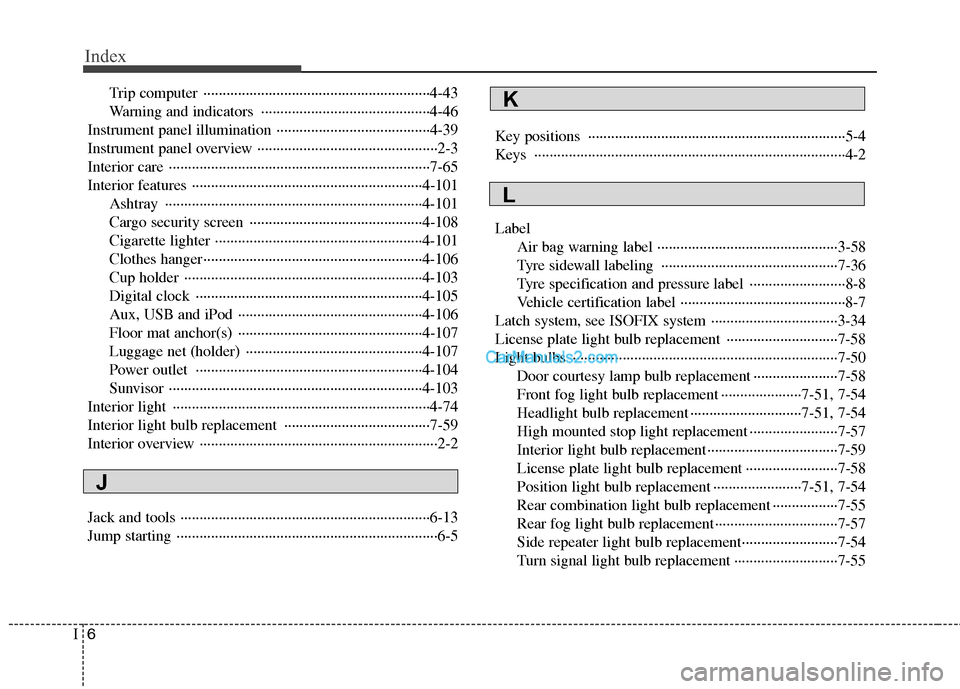
Index
6
I
Trip computer ···························································4-43
Warning and indicators ············································4-46
Instrument panel illumination ········································4-39
Instrument panel overview ···············································2-3
Interior care ····································································7-65
Interior features ····························································4-101 Ashtray ···································································4-101
Cargo security screen ·············································4-108
Cigarette lighter ······················································4-101
Clothes hanger·························································4-106
Cup holder ······························································4-103
Digital clock ···························································4-105
Aux, USB and iPod ················································4-106
Floor mat anchor(s) ················································4-107
Luggage net (holder) ··············································4-107
Power outlet ···························································4-104
Sunvisor ··································································4-103
Interior light ···································································4-74
Interior light bulb replacement ······································7-59
Interior overview ······························································2-2
Jack and tools ·································································6-13
Jump starting ····································································6-5 Key positions ···································································5-4
Keys ·················································································4-2 Label
Air bag warning label ···············································3-58
Tyre sidewall labeling ··············································7-36
Tyre specification and pressure label ·························8-8
Vehicle certification label ···········································8-7
Latch system, see ISOFIX system ·································3-34
License plate light bulb replacement ·····························7-58
Light bulbs ·····································································7-50 Door courtesy lamp bulb replacement ······················7-58
Front fog light bulb replacement ·····················7-51, 7-54
Headlight bulb replacement ·····························7-51, 7-54
High mounted stop light replacement ·······················7-57
Interior light bulb replacement··································7-59
License plate light bulb replacement ························7-58
Position light bulb replacement ·······················7-51, 7-54
Rear combination light bulb replacement ·················7-55
Rear fog light bulb replacement································7-57
Side repeater light bulb replacement·························7-54
Turn signal light bulb replacement ···························7-55
L
K
J